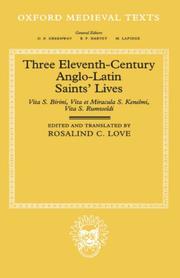| Listing 1 - 3 of 3 |
Sort by
|

ISBN: 0198205244 9780198205241 Year: 1996 Publisher: Oxford Clarendon
Abstract | Keywords | Export | Availability | Bookmark
 Loading...
Loading...Choose an application
- Reference Manager
- EndNote
- RefWorks (Direct export to RefWorks)
Medieval Latin literature --- Kenelm of Winchcombe --- Birinus of Dorchester-on-Thames --- Rumwold of Buckingham --- Christian literature, Latin (Medieval and modern) --- Christian saints --- Eleventh century --- Littérature chrétienne latine médiévale et moderne --- Saints chrétiens --- Onzième siècle --- Translations into English --- Legends --- Traductions anglaises --- Légendes --- Birinus, --- Kenelm, --- Rumwold, --- Translations into English. --- Legends. --- -Christian literature, Latin (Medieval and modern) --- -Latin Christian literature, Medieval and modern --- Latin literature, Medieval and modern --- Saints --- Canonization --- Classical influences --- Birinus Saint --- -Kenelm Saint --- -Rumwold Saint --- -Legends --- Littérature chrétienne latine médiévale et moderne --- Saints chrétiens --- Onzième siècle --- Légendes --- Latin Christian literature, Medieval and modern --- Rumbald, --- Rumbold, --- Rumwald, --- Cynhelm, --- Kenelme, --- Kenelmus, --- Berin, --- Birin, --- Christian literature, Latin (Medieval and modern) - England - Translations into English. --- Christian saints - England - Legends. --- Christian literature, Latin (Medieval and modern) - England.

ISBN: 0198208154 9780198208150 Year: 2004 Volume: *37 Publisher: Oxford Clarendon
Abstract | Keywords | Export | Availability | Bookmark
 Loading...
Loading...Choose an application
- Reference Manager
- EndNote
- RefWorks (Direct export to RefWorks)
Christian hagiography --- Christian women saints --- Hagiographie chrétienne --- Saintes chrétiennes --- Hagiographie chrétienne --- Saintes chrétiennes --- Christian saints, Women --- Women Christian saints --- Christian saints --- Women saints --- Hagiography, Christian --- Hagiography --- Christian women saints - England - Ely --- Ely --- Saintes --- Withburga v. regia in Anglia --- Etheldreda regina abb. Eliensis --- Sexburga regina abb. Eliensis --- Werburga seu Wereburga abb. Eliensis --- Ermenilda regina Merciae et abb. Eliensis
Book
ISBN: 9780199665204 0199665206 Year: 2013 Volume: *43 Publisher: Oxford : Clarendon Press,
Abstract | Keywords | Export | Availability | Bookmark
 Loading...
Loading...Choose an application
- Reference Manager
- EndNote
- RefWorks (Direct export to RefWorks)
The Warenne Chronicle is the more appropriate name for the Latin text known as the Hyde Chronicle. It covers the period from 1035 - the year in which Robert the Magnificent, duke of Normandy, died - up to the account of the White ship disaster in November 1120 when William Adelin, eldest son and heir of King Henry I, lost his life at the age of eighteen. The chronicle therefore covers the history of Normandy and England around the Norman Conquest of England with special reference to the earls of Warenne in Normandy. It is not a full blown dynastic history of this aristocratic family, but rather a historical narrative that emphasises the loyal support of the earls to the Norman rulers. The crucial question as to how far the Warenne chronicler may have covered the years beyond 1120 is impossible to settle definitively. The new argument put forward here is that the Warenne Chronicle was written early in the reign of King Henry II, probably shortly after 1157, for King Stephen's son William and his wife Isabel, heiress of Warenne, to provide an account of the invaluable help her ancestors had given to the Anglo-Norman rulers. Although the chronicle has survived anonymously, the suggestion is made that the author may have been Master Eustace of Boulogne, clerk and chancellor of William of Blois as fourth earl of Warenne. Unique information, other than that pertaining to the Warennes, concerns the commemoration of Queen Edith/Matilda, Henry I's rule in western Normandy, and the use of the word 'normananglus' (Norman-English) for the inhabitants of England of Norman origin.
De Warenne family --- History --- Sources --- Great Britain --- Grande-Bretagne --- Early works to 1800. --- Histoire --- Ouvrages avant 1800 --- De Warenne, William, --- Guillaume de Warenne, --- British library --- Manuscrit. Cotton Domitian A XIV. --- De Warenne, William, - 1st, - Earl of Surrey, - -1088 --- Great Britain - History - Norman period, 1066-1154 --- Great Britain - History - Edward, the Confessor, 1042-1066 --- Great Britain - History - Edward, the Confessor, 1042-1066 - Early works to 1800 --- Great Britain - History - Norman period, 1066-1154 - Early works to 1800
| Listing 1 - 3 of 3 |
Sort by
|

 Search
Search Feedback
Feedback About UniCat
About UniCat  Help
Help News
News